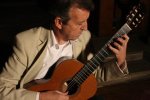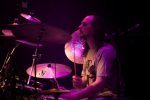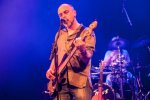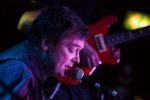And to accompany the review of The John Hackett Band's new album, the band give us the lowdown on it and what life if like as a member of the John Hackett Band. Over to you boys…
TWR: We Are Not Alone, a bold statement, do you think it is a true one…
JH: Like a lot of things you can take it in different ways. I certainly think we live in very dangerous times. But whether it is a tower block fire or a natural disaster somewhere in the world it is often the coming together of people to help each other in times of crisis that defines us and helps give meaning to our existence.
NF: I liked the title because I had spent many years of my life making music as a solo musician that to be part of something more social made a nice change from being my usual hermitic self. Performing solo concerts can be a lonely endeavour so making music with the chaps and not being ‘alone’ is very nice.
JR: It’s true (It’s just a little quiet sometimes).
TWR: This album is quite radically different from its predecessors, was this a conscious decision to broaden the musical envelope? |
|
JH: The big difference is that this is very much a band album. All of the guys are strong writers themselves with experience of composing and recording. So it has been exciting to broaden the envelope as you say and have their creative input. With any previous rock albums the material was nearly all written by me, whereas on We Are Not Alone there are several tracks by band members who, of course, bring their own style. This has pushed us into certainly more improvisation than I am used to. For me this sits well alongside the more tightly arranged passages. It helps the music breathe a little more and isn’t afraid to take us to different places stylistically. A major parts of this has been letting my flute playing take a more prominent role after all, it is what I am best known for. I have really enjoyed integrating the flute into songs such as Take Control.
TWR: This is also a new band line up so tell us a little bit about your musical backgrounds and how you came to be involved with the John Hackett Band?
NF: I had been playing in an acoustic flute and guitar duo with John for a number of years so being asked to be part of the JHB was very nice but unexpected as I hadn’t been playing the electric guitar for the past twenty five years and thought my electric playing days were long gone.
JR: Following the launch for Another Life I popped up to Sheffield to jam with John, Nick and Duncan. Duncan and myself have been making music together on and off for thirty years and he seemed to feel I would be a good fit. We all got along really well and tuned in to each other as a band remarkably quickly so it went from there.
DSP: I am primarily a drummer, though I also play things with strings and know how keyboards work. I have also had a very long fascination with the technical aspects of music making.
The flute makes one of my favourite sounds and when I am writing it is often my go to instrument when I am sketching out melodies. When I finally came around to making my first album a few years ago I was in need of a player. A friend offered me his tickets to one of Steve’s Acoustic Trio gigs that was happening locally. I had always been an admirer of John’s flauting from what I had heard on Steve’s records and whilst watching the gig it occurred to me that I could ask John to play! He agreed to it and we got on well. As time has gone on not only have I done a lot of work with him on the technical side of music, but we’ve become good friends. As noted elsewhere, the band came together pretty much by accidental virtue of the album party for Another Life
TWR: Give us a bit of the background behind the tracks and how you developed them…
JR: I remember listening to Checking Out Of London and Another Life over and over I really wanted to feel my own way into the songs - to have bass parts at least notionally written before that first rehearsal. So, that’s what I did. I had an idea of which songs John wanted to do so I applied myself to them - sometimes just the bass just pounds out the groove , sometimes it’s a little more fancy. Stella and Jericho were demos the rest of the band felt would work for JHB so they got embedded in the set in much the same way as Queenie and Winds Of Change. |
|
DSP: Queenie * Elmo’s Perfect Day started out as a short melodic sketch with some short interludes written one lunchtime when I was working in an office in Manchester in 2006. At the time it was christened ‘Nachos’ and was less than two minutes long. A couple of years ago I played John about an hours’ worth of odds and ends I had hanging around and he really liked the tune, so it became earmarked for future use. When he band convened it was decided to try it out. I wrote a couple of extra sections. My admiration of Bill Bruford’s oeuvre is no particular secret, along with other jazz rock outfits like Brand X and Pierre Moerlen’s Gong. Along with the melodic head and rising bridge, I wanted to provide space for improvisations to allow the melodious talent within the band to shine. I love Bruford’s One Of A Kind which breaks down to virtually nothing in the middle then improvises its way back. I took this as a model - we break down to an ambient section to showcase various timbres and moods and then start with bass and build back to a full sound. The studio version was a bit more mapped out than the live version on Disc Two but we had more performance options so it was structured to take advantage of that. Live versions can run longer or shorter depending on the point at which Nick’s fingers are about to drop off!
The name is part of a series of ‘Queenie & Elmo’ tunes. The first. ‘Queenie & Elmo’s Picnic’ wa son the second of my Music For Stairlifts albums, there will be another on a future album. Who are Queenie and Elmo? Up to you, the tunes are tone poems about two people’s adventures, visualise them how you choose.
TWR : Is Never Gonna Make A Dime an autobiographical song?
JH: Yes, it is inspired by the Hackett family’s brief move to Canada. It was 1957 when, feeling that life in London wasn’t as adventurous as it could be, our mum and dad decided to move to Vancouver. At this time mum had never been abroad so considering there were no mobile phones and no Internet back then to suss the place out ahead of time, it was an incredibly brave thing to do.
Our dad, Peter had gone on ahead to find work and somewhere for us to live while our mum June, here sister Betty, my seven year old brother Steve and I (two at the time) followed on by ship several months later. I was too young to remember this but apparently Steve would wander off on his own on board ship for long periods of time only to return with loads of cash. When mum questioned him about this, it turned out he had been playing his harmonica to the crew and they had rewarded him with his first gig fees!
Things didn’t work out as well as they had hoped for in Vancouver hence the Never Gonna Make A Dime lyric (though there is a bit of artistic license here in that I don’t think she ever used those exact words). In the end mum got very home sick and we came back after about four months. Like many things in life you can look at it in different ways. Was it a failed and foolish venture? I don’t think so. I think it was very brave of them to take a risk on a new life. Nothing against Canada but it made them realise how much they loved living in London and they were not too proud to admit it and came home
TWR: There are lot more instrumentals on this album than on its predecessors, is there any reason for this ?
NF: Our guitarist can’t write words so tends to concentrate on more instrumental material which John seemed to like.
JR: I’m not sure I might separate song from instrumental so much in my head. In a love context you are trying to create an atmosphere, endeavouring to communicate a mood or an emotion in whatever you are playing - whether it be the gentility of Overnight Snow or the -in-your-face Ego & Id, One of the many attractive aspects of the kind of music we are making is that no one really bats an eyelid if you have got x number of instrumentals on your album. It is entirely accepted and I feel the musical landscape of an album is all the richer for it. |
|
DSP: I think it comes a lot from who we are as people. The majority of John and Nick’s performance work is in the purely instrumental domain; quite a lot of Jeremy’s writing is very song based ( though he also writes some beautiful orchestral pieces); and my writing is fairly evenly split between vocal and instrumental. So we have a lot of instrumental music around! The album is quite an honest reflection of who we are and how we express ourselves.
TWR: The band are gigging more often these days, as documented in the accompanying live CD, how does it feel to be out on the road again?
JH: It is great to meet people after gigs who have followed my career since the 1970’s. And it has been so affirming to have their reaction to the new band and the direction we are taking. You asked in your first question about broadening the musical envelope and if I am honest, there is always the slight doubt in my mind about whether we could pull off the mixture of instrumentals and songs live. But judging from the reaction we have had at gigs my fears have been put to rest - people seem to like the variety.
NF: It feels great, it has been very enjoyable to work with the chaps and we usually have a good time on stage together.
JR: First and foremost I am a writer. The intrinsic problem with that is that no one ends up hearing what you write unless you get out there and share it. Nonetheless the only way I was ever likely to go on the road was with people I reall got, and who got me. So I feel very fortunate. Bearing in mind, we’ve not really been together all that long we have packed a lot in and 2018 is set to be even busier. I find it fascinating how different a set can feel from venue to venue and how audiences respond to it - it is undoubtedly true that the band and the audience collaborate to make the evening in ways I didn’t appreciate before
DSP: My love for progressive music started when I was about eight listening to The Moody Blues , then Supertramp, Mike Oldfied, ELO and others before discovering Genesis, Yes etc as a teen. Right from the a start I wanted to be in some situation where I was playing that sort of music both in the studio and live.
Finding folk with the skill, and more importantly the will (!) to play wasn’t easy in the Eighties especially when one was still at school! Fortunately Jeremy and I were in the same year at school together, and started making appropriate noises, though not in a live environment. Throughout the Nineties I was involved with a few groups, but it wasn’t until the formation of the JHB that I finally found myself in a place where I could play this more complicated music with likeminded folk. It is a pure joy to be able to count ‘one, two, three, four’ and launch into a tune, playing it in front of people and I am heartened that those people appear to be happy to listen!
TWR: How do you go about building up a track? Is it a melody first, or a lyric…?
JR: Yikes! If I answer this question one way I will have to retract it in the next sentence. There is no set way. For along time I hoped there was just so there could be this standard process one could rely upon, but it is just not true. So how do you build a track? You show up.
DSP: My contribution thus far to the group has been instrumental. Queenie & Elmo’s Perfect Day started with some harmony, and an idea that I wanted something upbeat. The chords we use now are a simplification of what was originally written, we now just flick between FMajor7 and CMajor7. I wanted a very light jazzy melody and , as much by accident as by design, wrote something that dances around an Aminor blues scale. The other passages are primarily based around Dminor. When I write songs they are normally extruded from a short vocal phrase. I will have a line or couplet with a melody fully formed, and work outwards from there.
| From a technical perspective, the album started with each full band tune being knocked about in rehearsal. Demos were done in various different forms, depending on who wrote the piece. The demo and structure ironed out in rehearsal were then used as templates and the various final takes built up. At the start of the process I asked the others how they wanted the album to sound, and Nick piped up ‘ like it was recorded in the ‘70’s ‘ I kept that at the back of mind with all the recording and mixing processes. It has been quite gratifying the number of reviews that have, without prompting, said how much it feels like an album made in the ‘70’s. I feel my methods have been vindicated. |
|
TWR: What are the future plans for the John Hackett Band and for each of you individually?
JH: We certainly want to play a lot more live next year. We Are Not Alone has only been out since the end of September so we would like a lot more people to hear us play it live. We also have some videos of the band playing a few tracks from the album shot in a studio that will be going on social media which we hope will bring us to a wider audience.
Beyond that we are beginning to think about the next album and of course, that has to start with the writing process. We are getting together early in 2018 to pool ideas and see what direction we should go in. With such a wealth of talent in the band it is not going to be difficult to find material. But I don’t want to rush out the next album like on some kind of conveyor belt. One of the strengths of We Are Not Alone is that we had played most of those tracks live to road test them well before we got into the studio.
An exciting prospect. My thanks to John and the guys for taking the time to give us an insight into the latest album and we wish them every success for their coming endeavours.
Photographs in this feature are courtesy of Katy Parsons and Mark Comish.



